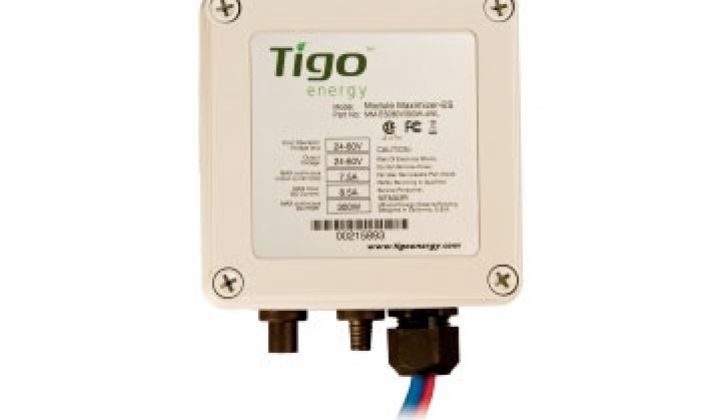Inverters represent about eight percent of the total cost of a solar installation and account for a fast-growing $2.5 billion market. The traditional method of stringing photovoltaic panels in series has inherent inefficiencies that Greentech Media Research has explored in deep detail (see "The Coming Disruption in the Inverter Market").
Entrepreneurs and VC investors have turned out in full force to confront these inverter reliability and performance issues with a number of different approaches. Companies like Tigo Energy, Solar Edge, National Semiconductor, and eIQ have designed distributed Maximum Power Point Tracking (MPPT) / DC-DC solutions which change the architecture or locate some of the power-conditioning electronics on the module. Microinverter startups like Enphase, PetraSolar, SolarBridge and others pair discrete, self-contained inverters with each solar panel.
In the words of solar PPA pioneer Jigar Shah, "It's a foregone conclusion that everyone is going to try a DC-to-DC solution." Shah said that we could see this beginning to transpire in as little as 18 months, citing improved power production, monitoring capabilities and the ability to swap panels from different vendors as the obvious value for this solution.
Validating that point, and just in time for Intersolar, REC Solar, one of the leading U.S. solar installers, and startup Tigo Energy just announced that the two companies have reached a development agreement to offer the Tigo product as part of REC Solar’s commercial and residential installations throughout the U.S.
I spoke with Jeff Krisa, Tigo Energy's VP of Sales and Marketing.
Krisa said, "Since the last time we talked [a few months ago] we really turned on the production machine," adding, "We've gone from R&D to prototype mode, in September we got the certifications from UL, CE and Japan. And now we are in sales mode and signing up distributors and the more aggressive installers."
According to Krisa, "Some of the larger companies worldwide are getting comfortable with the technology. REC looked at Tigo, did a full due diligence and have thrown their weight behind the Tigo solution."
"It differentiates them and enhances their value," said Krisa, adding, "They are bidding it to every residential job they do."
Having the intelligence at the panel level rather than at the string level is important to different customers for different reasons. "Germany wants to attack shaded roofs. Israel and Italy are jazzed about theft protection." He added that San Diego is interested because of fire safety -- firefighters can de-energize the arrays during a fire to protect firefighters' safety.
"What we've tried to do is develop a solution that scales well in large systems and even at utility scale. We're not a true DC-to-DC architecture." Krisa defined this approach as a distributed MPPT scheme where the firm can address underperforming modules and keep the efficiency very high.
"We address shade and troublesome implementation the same way other DC boost architectures do -- but in well-designed systems without shade, we can still gain five percent to six percent in performance."
The firm has done "a few half-megawatt jobs with a few megawatt jobs in the pipeline" and "are generally seen as bankable."
Tigo's current solution is a discrete box clipped onto the solar module mounting frame, but the endgame will be the integration of the chipset into the module itself. According to Krisa, about a half-dozen active development efforts for full integration are moving into compliance testing.
Shah might be right about the inevitability of this solution.
In a recent interview with Greentech Media, Sam Arditi, Tigo's CEO, said, "We do believe that we are much better positioned to be integrated into the panel. Our component count is much lower versus a microinverter, and that makes a lot more sense to module manufacturers." Arditi added, "In the coming 12 months, we think we will do 100 megawatts of installations -- that's not a small number."
Tigo's VC total to date is $27 million from Inventec Appliances Corporation (IAC), Clal Energy, Matrix Partners, OVP and ICV.
Partial List of DC-DC Inverter Architecture and Panel Maximizer Firms
- Accurate Solar
- eIQ
- MPPC
- National Semiconductor
- SolarEdge
- Tigo Energy
- Xandex



